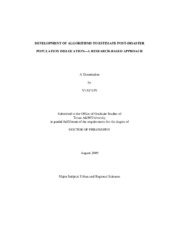| dc.contributor.advisor | Peacock, Walter G. | |
| dc.contributor.advisor | Lindell, Michael K. | |
| dc.creator | Lin, Yi-Sz | |
| dc.date.accessioned | 2010-10-12T22:31:19Z | |
| dc.date.accessioned | 2010-10-14T16:01:11Z | |
| dc.date.available | 2010-10-12T22:31:19Z | |
| dc.date.available | 2010-10-14T16:01:11Z | |
| dc.date.created | 2009-08 | |
| dc.date.issued | 2010-10-12 | |
| dc.date.submitted | August 2009 | |
| dc.identifier.uri | https://hdl.handle.net/1969.1/ETD-TAMU-2009-08-3266 | |
| dc.description.abstract | This study uses an empirical approach to develop algorithms to estimate
population dislocation following a natural disaster. It starts with an empirical reexamination
of the South Dade Population Impact Survey data, integrated with the
Miami-Dade County tax appraisal data and 1990 block group census data, to investigate
the effects of household and neighborhood socioeconomic characteristics on household
dislocation. The empirical analyses found evidence suggesting that households with
higher socio-economic status have a greater tendency to leave their homes following a
natural disaster. Then one of the statistical models is selected from the empirical analysis
and integrated into the algorithm that estimates the probability of household dislocation
based on structural damage, housing type, and the percentages of Black and Hispanic
population in block groups.
This study also develops a population dislocation algorithm using a modified
Hazard-US (HAZUS) approach that integrates the damage state probabilities proposed
by Bai, Hueste and Gardoni in 2007, accompanied with dislocation factors described in HAZUS to produce structural level estimates. These algorithms were integrated into
MAEviz, the Mid-American Earthquake Centers Seismic Loss Assessment System, to
produce post-disaster dislocation estimates at either the structure or block group level,
whichever is appropriate for the user's planning purposes. Sensitivity analysis follows to
examine the difference among the estimates produced by the two newly-developed
algorithms and the HAZUS population dislocation algorithm. | en |
| dc.format.mimetype | application/pdf | |
| dc.language.iso | en_US | |
| dc.subject | population dislocation | en |
| dc.subject | algorithm development | en |
| dc.subject | socioeconomic status | en |
| dc.subject | HAZUS | en |
| dc.subject | MAEviz | en |
| dc.title | Development of Algorithms to Estimate Post-Disaster Population Dislocation--A Research-Based Approach | en |
| dc.type | Book | en |
| dc.type | Thesis | en |
| thesis.degree.department | Landscape Architecture and Urban Planning | en |
| thesis.degree.discipline | Urban and Regional Sciences | en |
| thesis.degree.grantor | Texas A&M University | en |
| thesis.degree.name | Doctor of Philosophy | en |
| thesis.degree.level | Doctoral | en |
| dc.contributor.committeeMember | Wunneburger, Douglas F. | |
| dc.contributor.committeeMember | Popescu, Sorin C. | |
| dc.type.genre | Electronic Dissertation | en |
| dc.type.material | text | en |


